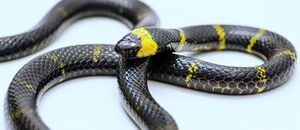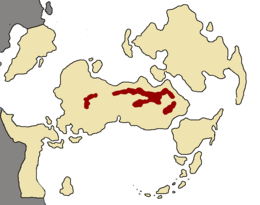Micrurus sidus: Difference between revisions
old>ContraViper No edit summary |
ContraViper (talk | contribs) No edit summary |
||
| (3 intermediate revisions by 2 users not shown) | |||
| Line 16: | Line 16: | ||
| binomial = Micrurus sidus | | binomial = Micrurus sidus | ||
| binomial_authority = Perón, 1784 | | binomial_authority = Perón, 1784 | ||
| range_map= Msidus range. | | range_map= Msidus range.png | ||
| range_map_width = 260px | | range_map_width = 260px | ||
| range_map_caption= Range of ''M. sidus'' | | range_map_caption= Range of ''M. sidus'' | ||
| Line 22: | Line 22: | ||
'''''Micrurus sidus''''', common name: '''Midnight coral snake''' also known as the '''Elapidé Minuès''' in [[Inyurstan]], is a species of venomous elapid snake found in the cloud forests of Marindino. It is restricted to both slopes of the central [[Sierra Miraco]] range. The biggest threat to this species is habitat loss of its intermediate montane forest habitat. | '''''Micrurus sidus''''', common name: '''Midnight coral snake''' also known as the '''Elapidé Minuès''' in [[Inyurstan]], is a species of venomous elapid snake found in the cloud forests of Marindino. It is restricted to both slopes of the central [[Sierra Miraco]] range. The biggest threat to this species is habitat loss of its intermediate montane forest habitat. | ||
==Habitat== | |||
The Midnight coral snake is endemic to middle-ring cloud forests, which sustain high annual amounts of rainfall, less sunlight penetration and stable temperatures. Typical temperature range is 16<sup>o</sup>C (61<sup>o</sup>F) - 25<sup>o</sup>C (77<sup>o</sup>F), with colder months rarely dropping below 10<sup>o</sup>C and warmer months rarely breaking 29<sup>o</sup>C. Important features of this habitat include layering ground ferns and loose, loamy soil interspaced with rocks. | |||
Habitat loss due to expansion of agriculture and logging form the main threat to this habitat. However, ''M. sidus'' is able to persist in areas where the habitat has been heavily altered, such as the botanical gardens in [[Minor Inyurstan Cities|Antioquia]]. | |||
==Life History== | |||
==Venom== | |||
This species is the most venomous snake in the country, with a mean subcutaneous LD<sub>50</sub> value of 0.9mg/kg; but is very secretive and usually non-aggressive, making it unlikely to stike humans. Only one casualty has been reported wherein a rancher was camping on the ground and one of these snakes slithered into his sleeping bag, and struck him upon being disturbed. | This species is the most venomous snake in the country, with a mean subcutaneous LD<sub>50</sub> value of 0.9mg/kg; but is very secretive and usually non-aggressive, making it unlikely to stike humans. Only one casualty has been reported wherein a rancher was camping on the ground and one of these snakes slithered into his sleeping bag, and struck him upon being disturbed. | ||
[[Category:Inyursta]], [[Category:Inyurstan Wildlife]] | [[Category:Inyursta]], [[Category:Inyurstan Wildlife]] | ||
Latest revision as of 18:18, 6 February 2022
| Midnight coral snake | |
|---|---|

| |
| Micrurus sidus | |
| Scientific classification | |
| Kingdom: | Animalia
|
| Phylum: | Chordata
|
| Class: | Reptilia
|
| Order: | Squamata
|
| Family: | Elapidae
|
| Genus: | Micrurus
|
| Species: | M. sidus
|
| Binomial name | |
| Micrurus sidus Perón, 1784
| |

| |
| Range of M. sidus | |
Micrurus sidus, common name: Midnight coral snake also known as the Elapidé Minuès in Inyurstan, is a species of venomous elapid snake found in the cloud forests of Marindino. It is restricted to both slopes of the central Sierra Miraco range. The biggest threat to this species is habitat loss of its intermediate montane forest habitat.
Habitat
The Midnight coral snake is endemic to middle-ring cloud forests, which sustain high annual amounts of rainfall, less sunlight penetration and stable temperatures. Typical temperature range is 16oC (61oF) - 25oC (77oF), with colder months rarely dropping below 10oC and warmer months rarely breaking 29oC. Important features of this habitat include layering ground ferns and loose, loamy soil interspaced with rocks.
Habitat loss due to expansion of agriculture and logging form the main threat to this habitat. However, M. sidus is able to persist in areas where the habitat has been heavily altered, such as the botanical gardens in Antioquia.
Life History
Venom
This species is the most venomous snake in the country, with a mean subcutaneous LD50 value of 0.9mg/kg; but is very secretive and usually non-aggressive, making it unlikely to stike humans. Only one casualty has been reported wherein a rancher was camping on the ground and one of these snakes slithered into his sleeping bag, and struck him upon being disturbed.,